neur1020
0.0(0)
0.0(0)
Card Sorting
1/96
There's no tags or description
Looks like no tags are added yet.
Study Analytics
Name | Mastery | Learn | Test | Matching | Spaced |
|---|
No study sessions yet.
97 Terms
1
New cards
Paradigms:
Psychodynamic and humanist paradigms are important for their contribution to discipline and clinical practice
Behaviourist, cognitive and biological paradigms lay the foundation upon which much of modern experimental psychology has been built
A paradigm is a framework for understanding and investigative phenomena within a discipline
Behaviourist, cognitive and biological paradigms lay the foundation upon which much of modern experimental psychology has been built
A paradigm is a framework for understanding and investigative phenomena within a discipline
2
New cards
the behavioural paradigm
root metaphor of the blank slate
* behaviour are wholly determined by our environment
key concepts of history of reinforcement and learning
* law of affect (rewarded is repeated)
* rejection of unobservable processes as unscientific
question about how contingencies pairing stimuli with reward punishment effect subsequent behaviour
* studied experiment
* behaviour are wholly determined by our environment
key concepts of history of reinforcement and learning
* law of affect (rewarded is repeated)
* rejection of unobservable processes as unscientific
question about how contingencies pairing stimuli with reward punishment effect subsequent behaviour
* studied experiment
3
New cards
the cognitive paradigm
root metaphor of computer
* inputs are processed and transformed into outputs (behaviour)
key concepts of mental representations and mental states
* focus on unobservable mental processes and their effects
* attention memory decisionmaking
questions about the mental processes that give rise to this
* studied experimentally often with humans
* inputs are processed and transformed into outputs (behaviour)
key concepts of mental representations and mental states
* focus on unobservable mental processes and their effects
* attention memory decisionmaking
questions about the mental processes that give rise to this
* studied experimentally often with humans
4
New cards
the biological paradigm
root metaphor of the biological machine
* what are the physical bases of thought and behaviour
key concepts of evolution genetics physiological functions
* focus on identifying physiological correlations of specific behaviours
* measurement of brain activity and identification of genetic contributions to behaviours or physiological disorders
questions about how mental process is realised in the brain and how it evolved
studied experimentally on humans and animals and case studies
* what are the physical bases of thought and behaviour
key concepts of evolution genetics physiological functions
* focus on identifying physiological correlations of specific behaviours
* measurement of brain activity and identification of genetic contributions to behaviours or physiological disorders
questions about how mental process is realised in the brain and how it evolved
studied experimentally on humans and animals and case studies
5
New cards
**Placebo effect**
a beneficial effect produced by a placebo drug or treatment, which cannot be attributed to the properties of the placebo itself, and must therefore be due to the patient's belief in that treatment
6
New cards
**Hawthorne Effect**
the alteration of behaviour by the subjects of a study due to their awareness of being observed.
7
New cards
**Stereotype Threat**
Stereotype threat is a situational predicament in which people are or feel themselves to be at risk of conforming to stereotypes about their social group
8
New cards
**Demand Effects**
bias that occurs when participants infer the purpose of an experiment and respond so as to help confirm a researcher's hypothesis.
9
New cards
expectation effects
* single blind research can restrict participant knowledge of study aims (combats participant expectations)
* bias from experimental expectations (Rosenthal effect-Pygmalion/golem)
* Double blind research can restrict experiment and knowledge of participant groups (combats experimenter expectations)
* bias from experimental expectations (Rosenthal effect-Pygmalion/golem)
* Double blind research can restrict experiment and knowledge of participant groups (combats experimenter expectations)
10
New cards
the brain
2% of body weight
receives 20% of blood pumped from the heart
consumes 20% of the body's energy
100 billion neurons
1000000 billion synapses
10^1000000 possible circuits
receives 20% of blood pumped from the heart
consumes 20% of the body's energy
100 billion neurons
1000000 billion synapses
10^1000000 possible circuits
11
New cards
three parts of brain
cerebrum- two hemispheres
cerebellum (hindbrain)
* cerebral cortex: outermost layer of the cerebellum= gray matter
* contains most of the neurons
* two to four millimetres thick
* highly folded to maximise surface area
* white matter underneath the grey matter is the wiring
brain stem
cerebellum (hindbrain)
* cerebral cortex: outermost layer of the cerebellum= gray matter
* contains most of the neurons
* two to four millimetres thick
* highly folded to maximise surface area
* white matter underneath the grey matter is the wiring
brain stem
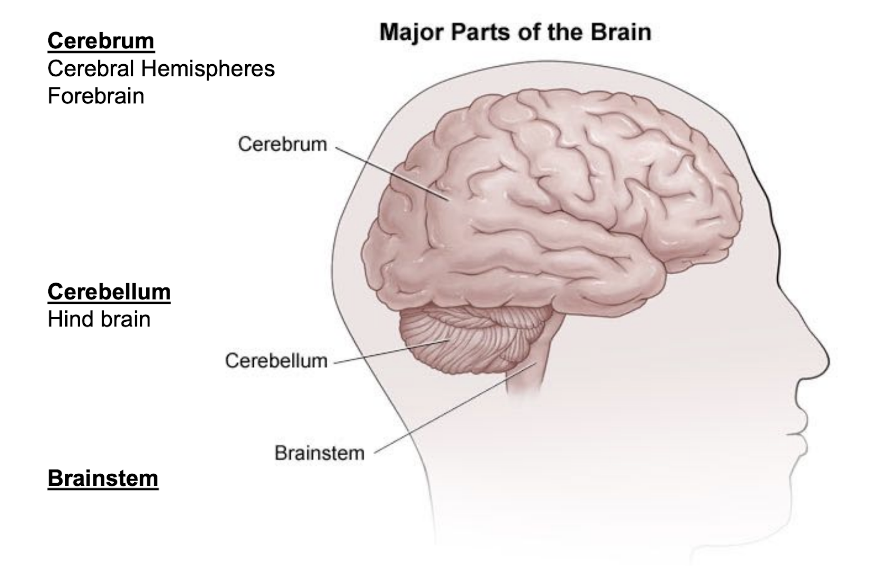
12
New cards
Primary sense
Sight= occipital lobe
Hearing= temporal lobe
Taste= parietal lobe
Touch= parietal lobe
Movement= frontal lobe
* first site of input/last site of output
Hearing= temporal lobe
Taste= parietal lobe
Touch= parietal lobe
Movement= frontal lobe
* first site of input/last site of output
13
New cards
frontal lobe
executive functions: reasoning, planning, problem solving, inhibitory control, working memory
motor functions:
* premotor cortex= motor planning,
* primary motor cortex= execution
speech production
motor functions:
* premotor cortex= motor planning,
* primary motor cortex= execution
speech production
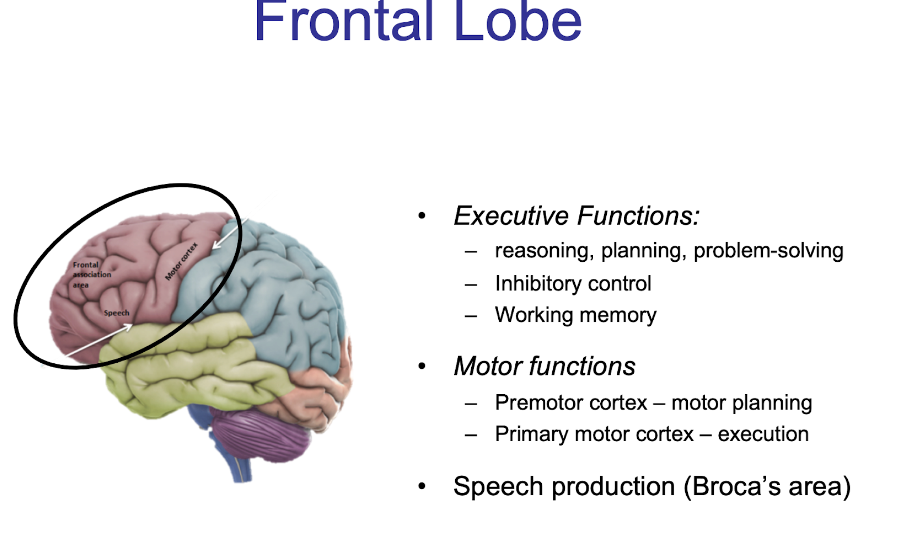
14
New cards
Parietal lobe
Primary somatosensory cortex (touch)
sense of space and locations
spatial attention- directing attention and eye movements
linking vision to action
sense of space and locations
spatial attention- directing attention and eye movements
linking vision to action
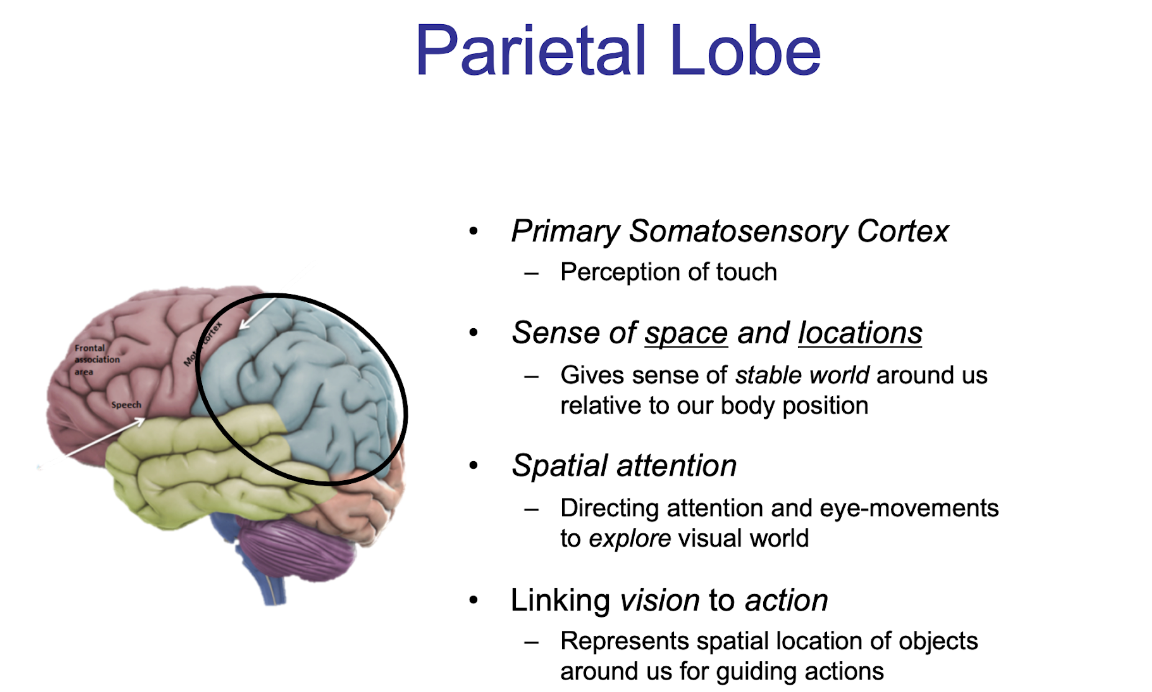
15
New cards
Occipital lobe
primary visual cortex (VI) all vision perception
higher visual areas: different regions process shape, colour, orientation, movement
higher visual areas: different regions process shape, colour, orientation, movement

16
New cards
temporal lobe
primary auditory cortex
language comprehension
medial temporal lobe: limbic system (learning and memory)
* amygdala: fear and arousal
* hippocampus: learning and memory (forming new episodic memory)
language comprehension
medial temporal lobe: limbic system (learning and memory)
* amygdala: fear and arousal
* hippocampus: learning and memory (forming new episodic memory)
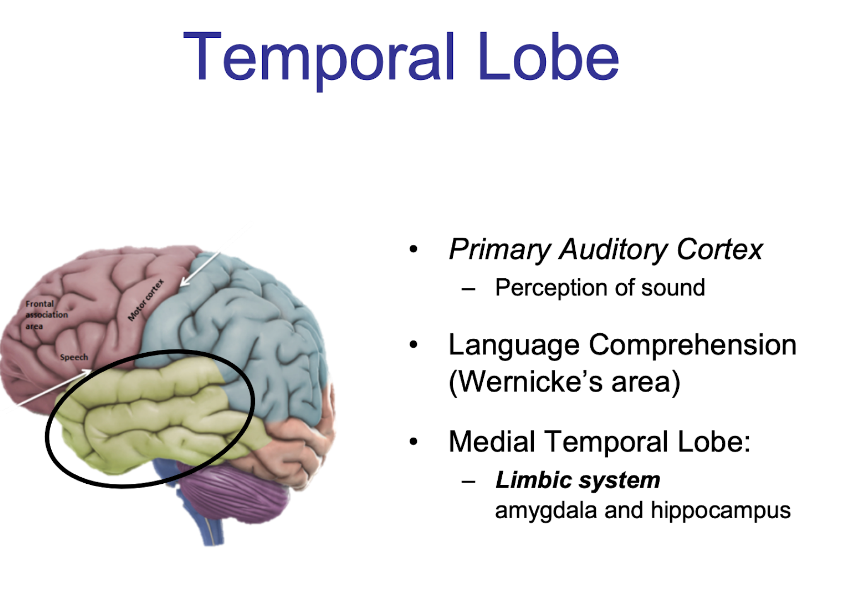
17
New cards
corpus callosum
neuron connections between left and right hemispheres
allows communication within brain
allows communication within brain
18
New cards
Broca’s area 1861
left frontal lobe damage
lack of speech
Broca’s aphasia: speech disorder
lack of speech
Broca’s aphasia: speech disorder
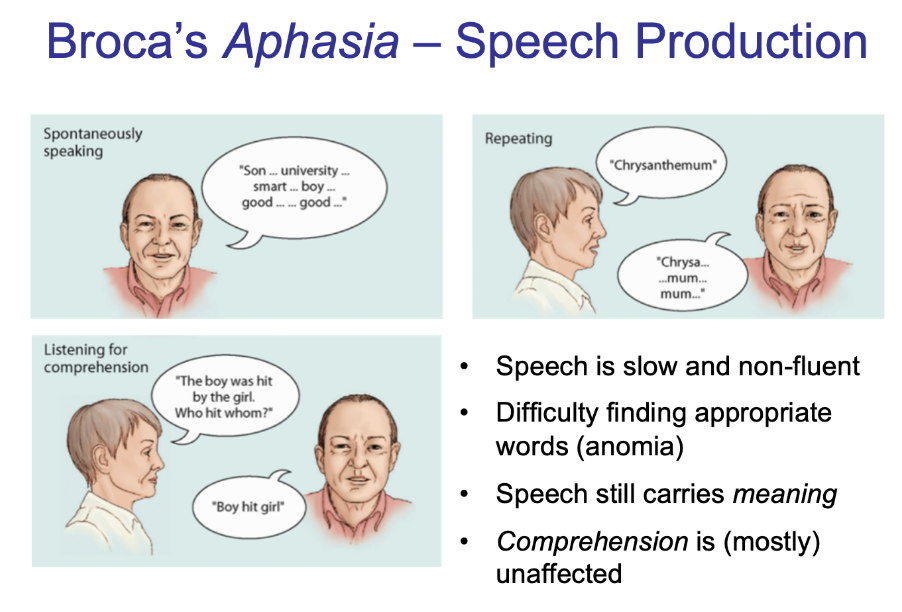
19
New cards
Wernicke’s area 1874
Left posterior temporal lobe
language comprehension
Wernicke’s aphasia: can speak fluently but it's nonsense
language comprehension
Wernicke’s aphasia: can speak fluently but it's nonsense
20
New cards
Wilder Renfield 1951
electrical stimulation to brain during surgery
maps of motor and sensory cortices
maps of motor and sensory cortices
21
New cards
peripheral nervous system (brainstem)
autonomic nervous system
* involuntary
* heart rate, respiration, sweating, stress, arousal, fight or flight
Somatic nervous system
* Voluntary
* motor and sensory
* involuntary
* heart rate, respiration, sweating, stress, arousal, fight or flight
Somatic nervous system
* Voluntary
* motor and sensory
22
New cards
central nervous system (brainstem)
brain and spinal cord
23
New cards
autonomic nervous system (brainstem)
two divisions
sympathetic nervous system
* emotional arousal, stressed, fear
* fight or flight
* increases heart rate, respiration, perspiration, pupil dilation
parasympathetic nervous system
* rest and digest
* lowers heart rate, respiration
* increases stomach intestine activity
* opposes sympathetic system
sympathetic nervous system
* emotional arousal, stressed, fear
* fight or flight
* increases heart rate, respiration, perspiration, pupil dilation
parasympathetic nervous system
* rest and digest
* lowers heart rate, respiration
* increases stomach intestine activity
* opposes sympathetic system
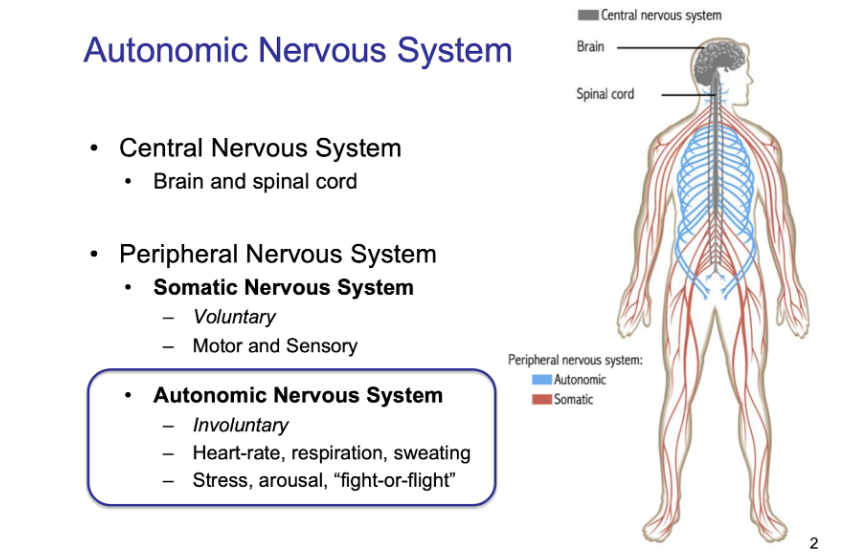
24
New cards
Medulla (brainstem)
autonomic nervous system functions
controls heart rate, blood pressure, temperature, respiration
reflex centre for coughing, sneezing, swallowing, vomiting
controls heart rate, blood pressure, temperature, respiration
reflex centre for coughing, sneezing, swallowing, vomiting
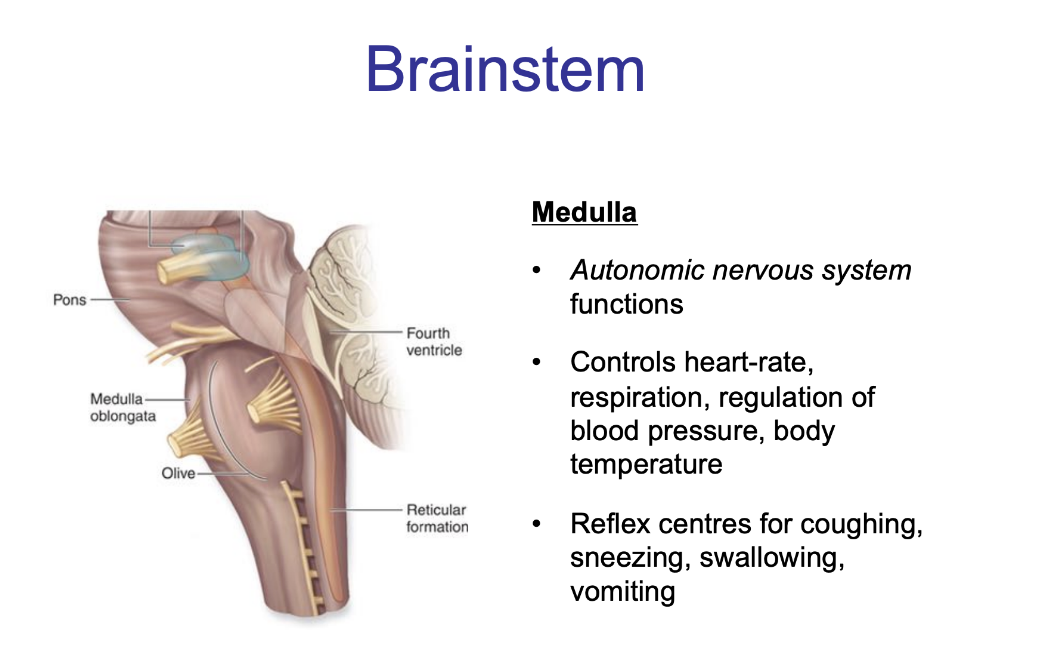
25
New cards
Low level to high level functions responsible (brainstem)
Brainstem (ANS) low.
Cerebral hemispheres- cortex (planning, reasoning, language,
perception) high
Cerebral hemispheres- cortex (planning, reasoning, language,
perception) high
26
New cards
Cerebellum
\
hind brain
sense of balance and coordination of complex movements
motor learning- fine adjustment of movement based on feedback
primary motor and sensory areas
* primary motor cortex activity leads to movements
* primary sensory cortex activity leads to sensation
* different parts control different parts of body (homunculus)
* motor programme for movement
- brain creates programmes in brain before movement
- brain retrieves programme for learned skilled actions
* feedback control of action
- sensory feedback
* sense of agency
- Brain automatically links sensory events and own-actions to infer causality
- can't tickle yourself
hind brain
sense of balance and coordination of complex movements
motor learning- fine adjustment of movement based on feedback
primary motor and sensory areas
* primary motor cortex activity leads to movements
* primary sensory cortex activity leads to sensation
* different parts control different parts of body (homunculus)
* motor programme for movement
- brain creates programmes in brain before movement
- brain retrieves programme for learned skilled actions
* feedback control of action
- sensory feedback
* sense of agency
- Brain automatically links sensory events and own-actions to infer causality
- can't tickle yourself
27
New cards
neurons
cell body
* contains nucleus and DNA and functional things
dendrites
* received signals
* input from other neurons
AXON
* sends signals- output from Axon hillock to axon terminals
* one per neuron
* wrapped in myelin for efficient transmission
Axon terminals
* terminal buttons
* form synapses with other neurons
* secrete neurotransmitters to send signals to other neurons
* contains nucleus and DNA and functional things
dendrites
* received signals
* input from other neurons
AXON
* sends signals- output from Axon hillock to axon terminals
* one per neuron
* wrapped in myelin for efficient transmission
Axon terminals
* terminal buttons
* form synapses with other neurons
* secrete neurotransmitters to send signals to other neurons
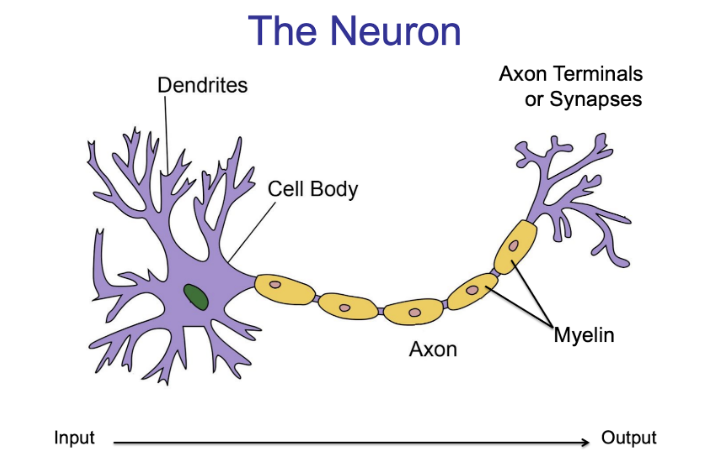
28
New cards
glial cells
oligodendrocytes- produce myelin sheath
astrocytes- supply nutrients from blood to neurons, maintain blood-
brain barrier
microglia- brains immune system, cleans up foreign/toxic substance
astrocytes- supply nutrients from blood to neurons, maintain blood-
brain barrier
microglia- brains immune system, cleans up foreign/toxic substance
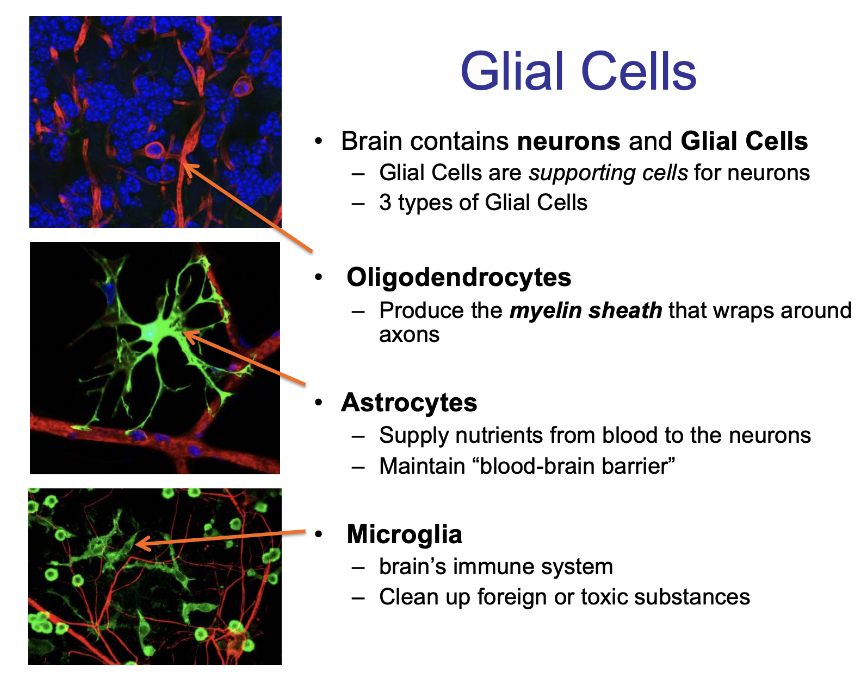
29
New cards
myelin
0\.3-4micro meters
Wraps around axons
Wraps around axons
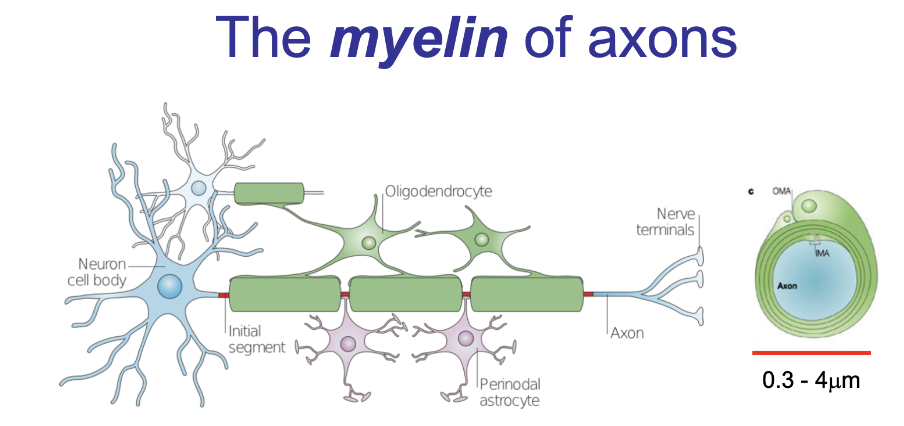
30
New cards
Action potentials = neuron signals
Electrical signal pulse travels along the axon
Fixed size- either on or off
Fixed size- either on or off
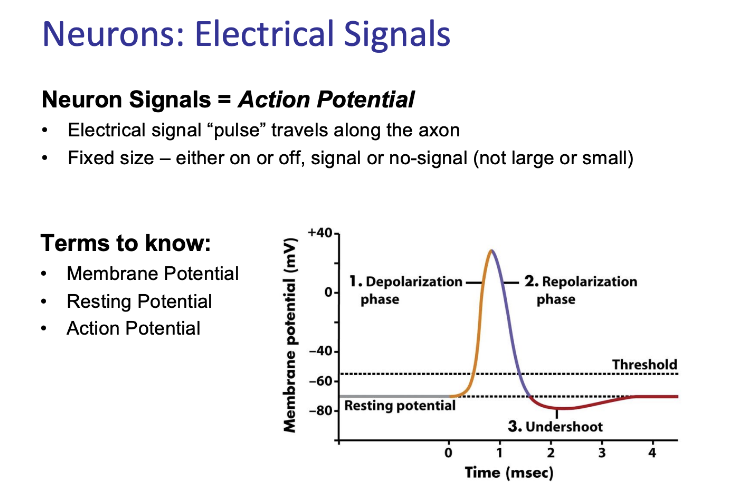
31
New cards
Cell membrane wall
Forms barrier between extra-cellular and intra-cellular fluid
Na+ and K+ ions across cell membrane
Different concentrations inside and outside cell
Gives different in electrical charge (membrane potential)
Na+ and K+ ions across cell membrane
Different concentrations inside and outside cell
Gives different in electrical charge (membrane potential)
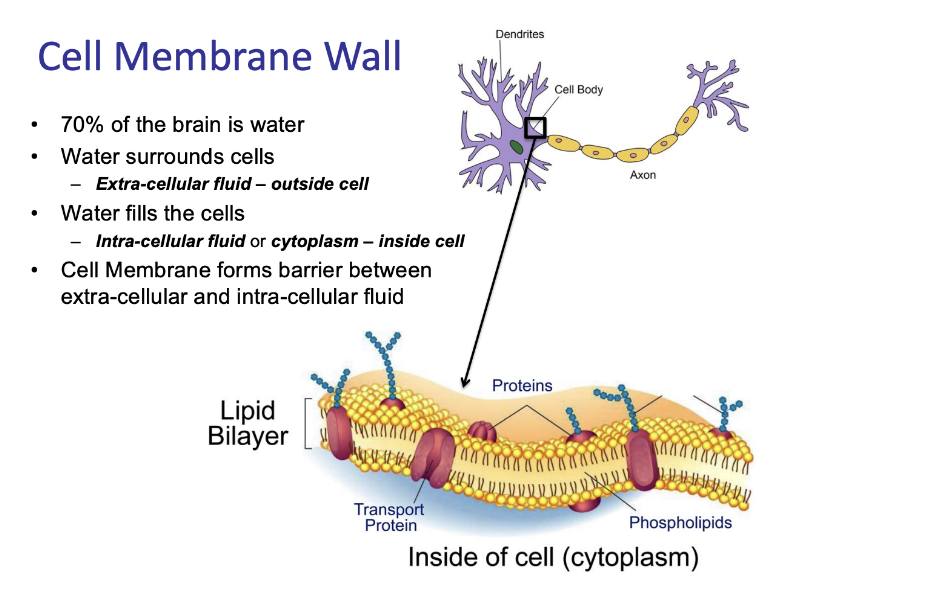
32
New cards
Resting potential:
AT REST MORE POSITIVE IONS OUTSIDE CELL GIVES inside cell an
overall negative potential voltage (-70mV)
overall negative potential voltage (-70mV)
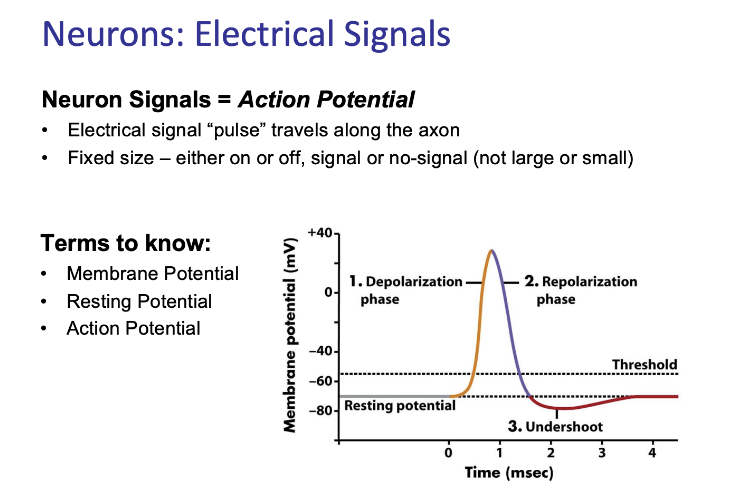
33
New cards
Ion channels in cell membrane
Open and close to allow movement of ions across cell membrane
Changes electrical potential
Sodium potassium pump
* Pumps Na and K across cell membrane (3Na out for every 2K
in)
* Pumps positive charge out of cell
* Maintains -ve resting potential
* Uses energy- 70% of brain energy, 25% of body energy
Action potential
* Input from other neurons icreases membrane potential
* If voltage exceeds threshold, triggers action potential
* Depolarisation of cell- membrane potential goes to 0 (Na flow inside cell)
* Repolarisation of cell: membrane potential back to -70mV (K flow out of cell)
Voltage dependent ion channel
* Closed at resting potential
* Open when membrane potential reaches threshold
* Allows flow of ions across cell membrane
Refractory period
* Membrane potential is further away from threshold needed to trigger an action potential
Action Potential conduction along axon
* Starts at axon hillock
- Lowest threshold to trigger AP
* Depolarisation spreads from site of action potential to neighbouring region, triggering them
Changes electrical potential
Sodium potassium pump
* Pumps Na and K across cell membrane (3Na out for every 2K
in)
* Pumps positive charge out of cell
* Maintains -ve resting potential
* Uses energy- 70% of brain energy, 25% of body energy
Action potential
* Input from other neurons icreases membrane potential
* If voltage exceeds threshold, triggers action potential
* Depolarisation of cell- membrane potential goes to 0 (Na flow inside cell)
* Repolarisation of cell: membrane potential back to -70mV (K flow out of cell)
Voltage dependent ion channel
* Closed at resting potential
* Open when membrane potential reaches threshold
* Allows flow of ions across cell membrane
Refractory period
* Membrane potential is further away from threshold needed to trigger an action potential
Action Potential conduction along axon
* Starts at axon hillock
- Lowest threshold to trigger AP
* Depolarisation spreads from site of action potential to neighbouring region, triggering them
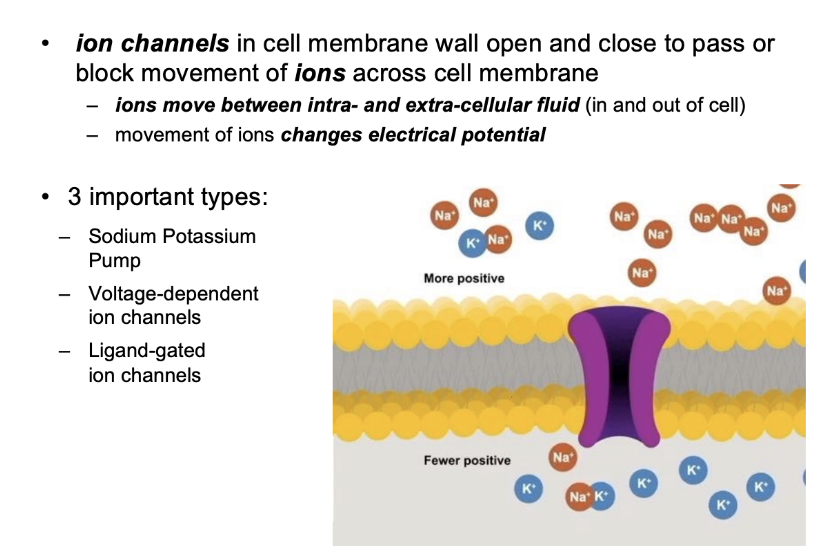
34
New cards
Excitatory neurotransmitters
Receptors opens channels causing depolarisation
EPSP: excitatory post-synaptic potential
Closer to threshold for action potential
EPSP: excitatory post-synaptic potential
Closer to threshold for action potential
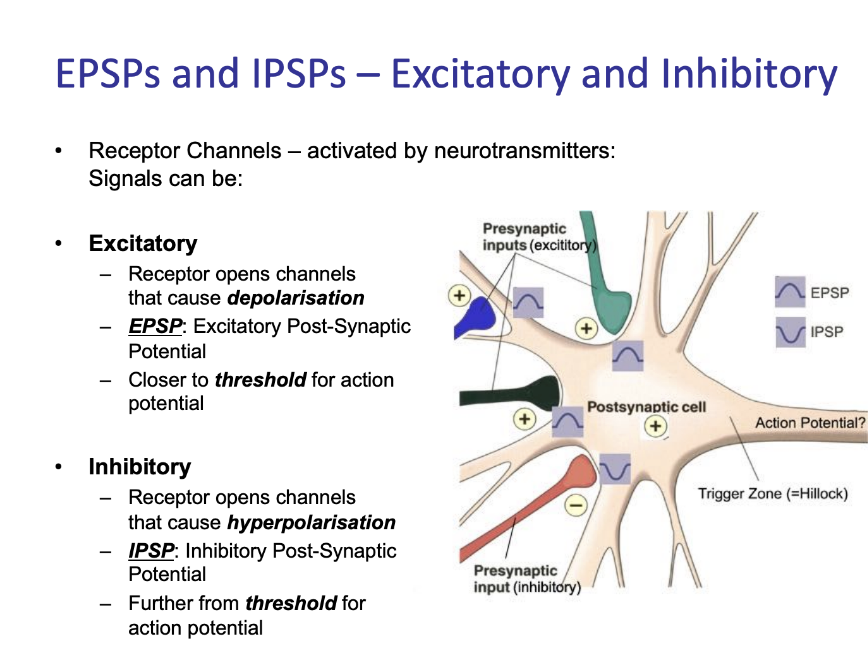
35
New cards
Inhibitory neurotransmitters
Receptors open channels that cause hyperpolarisation
IPSP
Further from threshold for action potentials
IPSP
Further from threshold for action potentials
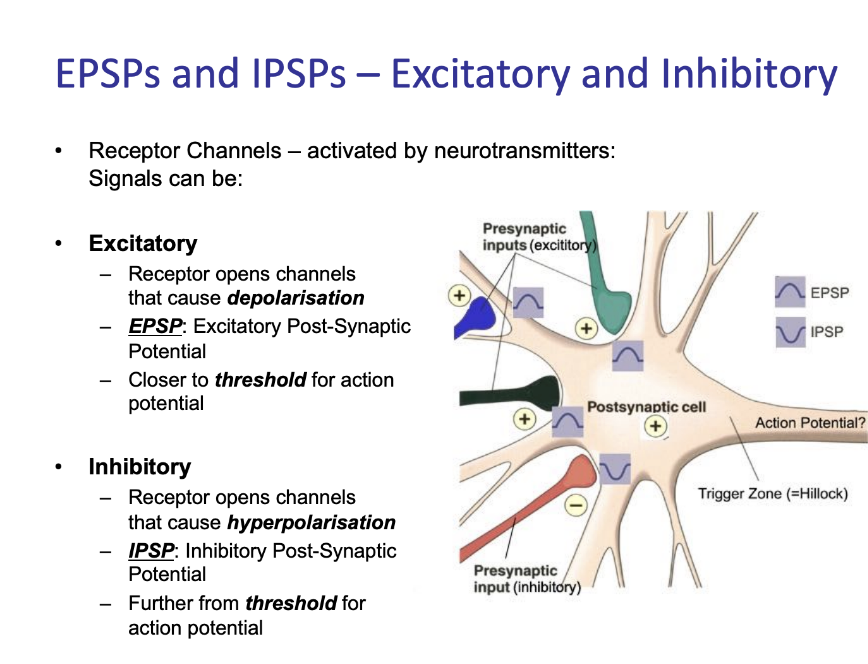
36
New cards
Graded potential
Excitatory and inhibitory input combines together
* Change Membrane potential on post-synaptic cell
Graded potential depends of strength of synapse connection
* Strong connect- large change in membrane potential
* Change Membrane potential on post-synaptic cell
Graded potential depends of strength of synapse connection
* Strong connect- large change in membrane potential
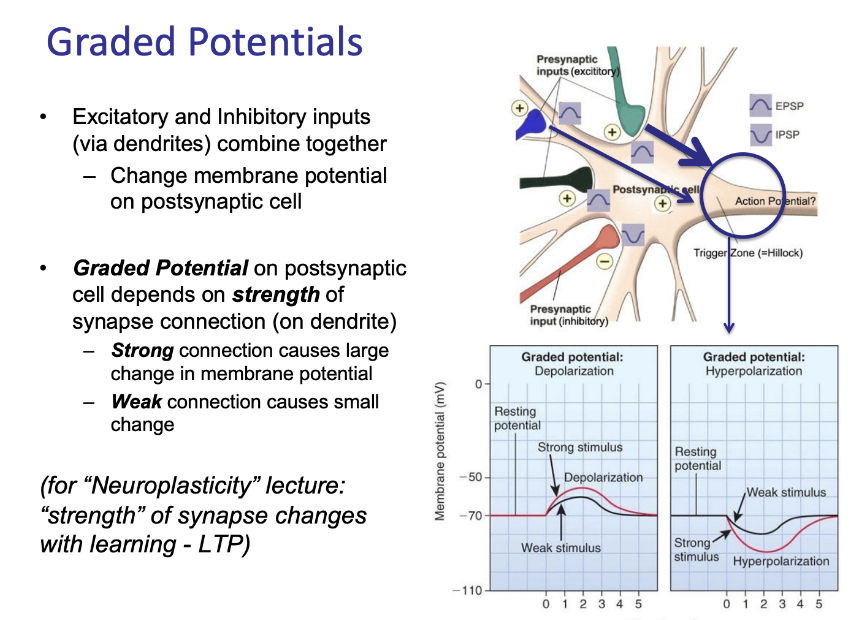
37
New cards
Membrane potential depends on sum and timing of inputs
if enough excitatory inputs occur close in time, Membrane potential will exceed threshold triggering action potential
38
New cards
Brain lesions (Measuring Brain functions)
Use patients with damages parts of their brain to examine what
changes in behaviour and cognition occur
changes in behaviour and cognition occur
39
New cards
Single neuron recording (Measuring Brain functions)
Place a thin electrode into an animals brain
Record action potentials firing from a single neuron
Measure what that neuron encodes or detects
Best localisation and timing of brain function
* Directly measuring action potentials from individual neurons
* Highly invasive
Record action potentials firing from a single neuron
Measure what that neuron encodes or detects
Best localisation and timing of brain function
* Directly measuring action potentials from individual neurons
* Highly invasive
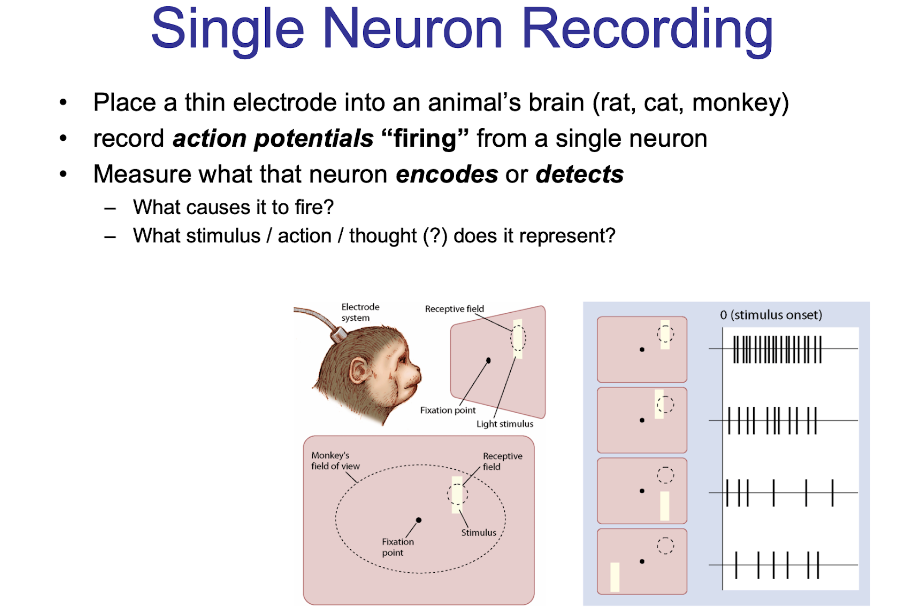
40
New cards
EEG- electroencephalography (Measuring Brain functions)
Summed activity from action potentials of neurons in the cortex cause
electrical activity change on the scalp
Measure voltage changes from electrode
Brain activity shows oscillations
Frequency of oscillations change with alertness and sleep
electrical activity change on the scalp
Measure voltage changes from electrode
Brain activity shows oscillations
Frequency of oscillations change with alertness and sleep
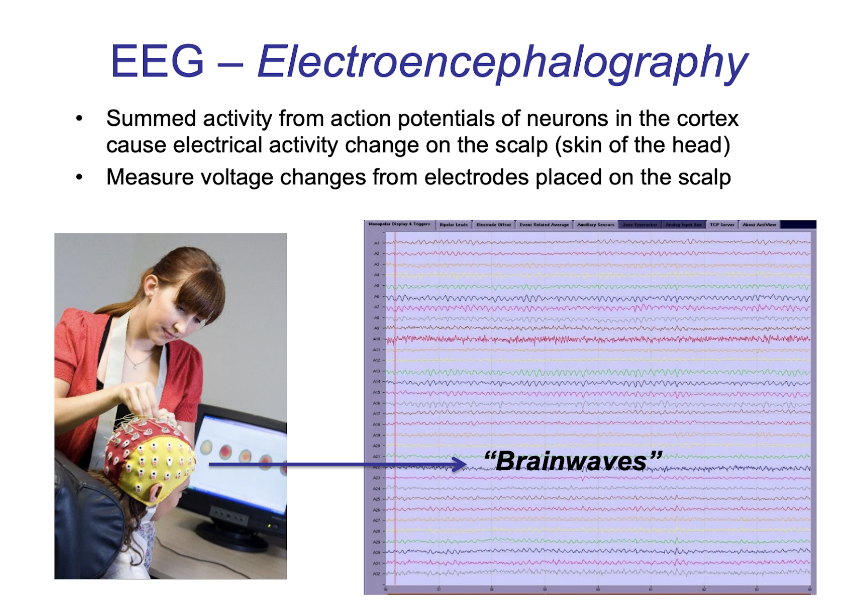
41
New cards
ERP- event related potentials (Measuring Brain functions)
Brain activity related to a specific event or stimulus
Average together 100 trials of EEGF in response to stimulus
Early brain processing of general visual features
Average together 100 trials of EEGF in response to stimulus
Early brain processing of general visual features
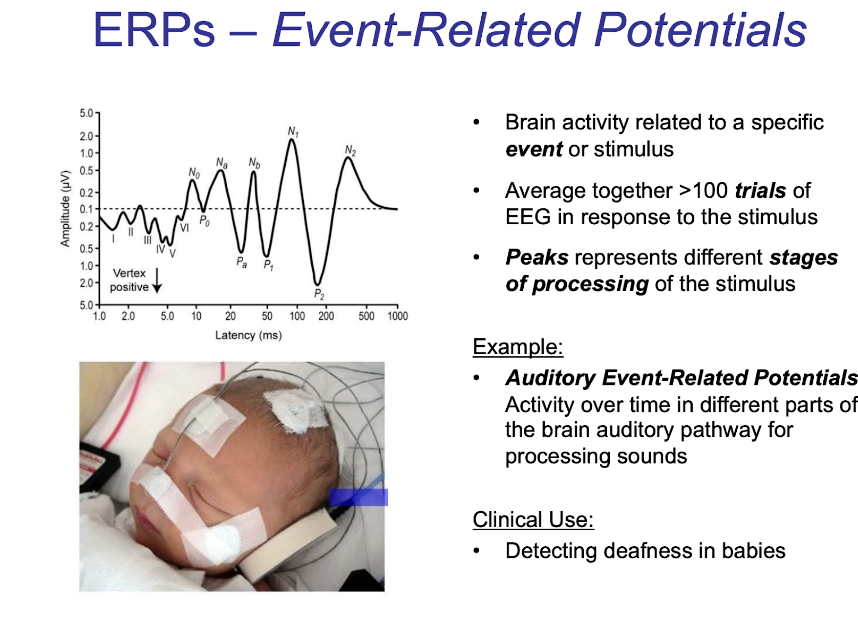
42
New cards
Functional brain imagery (Measuring Brain functions)
Change in blood flow associated with neuron activity
PET
* Used to map neurotransmitters or receptors
* Uses radioactive substance injected into blood stream
fMRI
* measures change in blood oxygen levels (active neurons use oxygen)
* studies brain function
* oxygen is carried in blood and delivered to active neurons
* change in blood oxygen levels =change in brain activity
* good localisation of brain activity’
PET
* Used to map neurotransmitters or receptors
* Uses radioactive substance injected into blood stream
fMRI
* measures change in blood oxygen levels (active neurons use oxygen)
* studies brain function
* oxygen is carried in blood and delivered to active neurons
* change in blood oxygen levels =change in brain activity
* good localisation of brain activity’
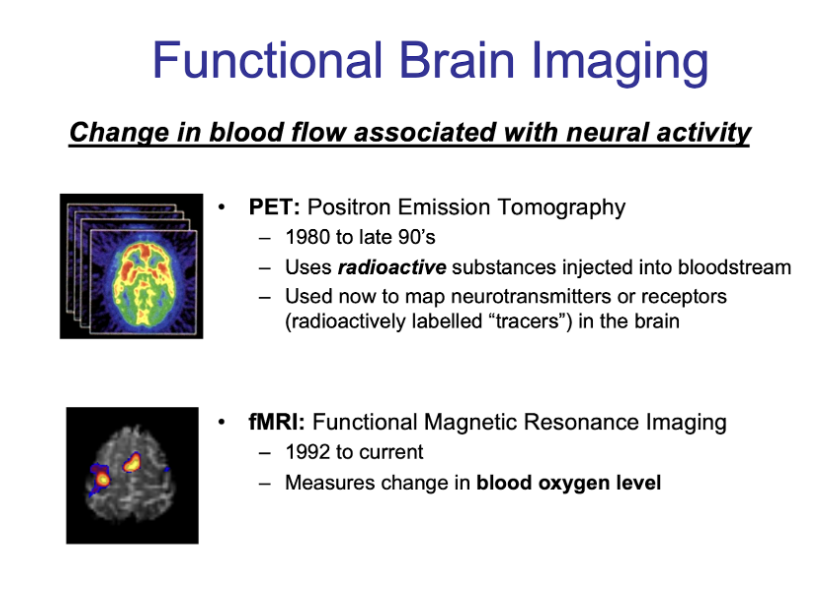
43
New cards
Brain plasticity and learning
Brain plasticity
* How the brain changes with learning
* The capability of the brain to alter its functional organisation as a result of experience
Neurogenesis and synaptogenesis
* Generation of new neurons and synapses
Integration of signals
* Neurons receive many inputs- has only one output
* What combination of outputs will cause neuron to fire
Grandmother cells
* Neurons could represent a specific concept
* Billions or neurons can encode billions of concepts
* Memory may be represented by groups of neurons each encoding specific concepts or objects
* Jennifer Anniston cells- found in hippocampus
* How the brain changes with learning
* The capability of the brain to alter its functional organisation as a result of experience
Neurogenesis and synaptogenesis
* Generation of new neurons and synapses
Integration of signals
* Neurons receive many inputs- has only one output
* What combination of outputs will cause neuron to fire
Grandmother cells
* Neurons could represent a specific concept
* Billions or neurons can encode billions of concepts
* Memory may be represented by groups of neurons each encoding specific concepts or objects
* Jennifer Anniston cells- found in hippocampus
44
New cards
Connections
Spreading activation model
* Neurons represent specific concept
* Share connections with neurons that represent related concepts
* Activation of one neuron leads to the spreading activation to related or connected neurons
Learning and memory
* Making and strengthening connections between neurons that represent associated concepts
* Neurons represent specific concept
* Share connections with neurons that represent related concepts
* Activation of one neuron leads to the spreading activation to related or connected neurons
Learning and memory
* Making and strengthening connections between neurons that represent associated concepts
45
New cards
Motion aftereffect
Sensory after effects
Usually the opposite experience relative to the adaptor
Associated with reduced responding in the brain to the adapted input
Can enhance the salience of new inputs, relative to old inputs, because the brain is more responsive to new inputs
Troxler fading
* When starring at a static scene
* New input appears brighter
Usually the opposite experience relative to the adaptor
Associated with reduced responding in the brain to the adapted input
Can enhance the salience of new inputs, relative to old inputs, because the brain is more responsive to new inputs
Troxler fading
* When starring at a static scene
* New input appears brighter
46
New cards
Perceptual after effects
Demonstrate that we do not have veridical experiences of sensory input
Our experiences are a product of activity in our brains, and that activity can promote experiences that differ from sensory input
Sensory adaption helps to ensure that perception is useful but it isn’t accurate
Our experiences are a product of activity in our brains, and that activity can promote experiences that differ from sensory input
Sensory adaption helps to ensure that perception is useful but it isn’t accurate
47
New cards
McGurk Effect
People do not have a veridical sense of input from any single sensory modality
Out brains tend to create perceptual experiences that sum together all the sensory information that is given to us
We can experience an averaging of audio and visual information, which is different to the audio and visual experiences we would have if those inputs were experienced in isolation
Sense organs
* Transduce environmental energy into electrochemical signals sent to your brain.
* Perception is your brains best running hypothesis about what is probably happening in the real world.
Out brains tend to create perceptual experiences that sum together all the sensory information that is given to us
We can experience an averaging of audio and visual information, which is different to the audio and visual experiences we would have if those inputs were experienced in isolation
Sense organs
* Transduce environmental energy into electrochemical signals sent to your brain.
* Perception is your brains best running hypothesis about what is probably happening in the real world.
48
New cards
Hearing
Relies of transformation of sound waves – vibrations that propagate through a medium into signals that can be sent to the brain.
Alternations in pressure on air molecules creates a sound wave with frequency (how often air pressure increases and decreases over time) and amplitude (Big changes = loud sounds, small = quiet)
How soundwaves are transformed
* Cochlea (inner ears) > Hair cells > Have bundles of “hair-like” stereocilia which extends into surrounding liquid and move back and forward when the liquid is vibrated by sound waves.
* Bending of stereocilia bends, ions rush to top of hair cells which releases chemicals at the base.
* These chemicals bind to auditory nerve cells creating an electrical an signal that propagates along auditory nerve
Alternations in pressure on air molecules creates a sound wave with frequency (how often air pressure increases and decreases over time) and amplitude (Big changes = loud sounds, small = quiet)
How soundwaves are transformed
* Cochlea (inner ears) > Hair cells > Have bundles of “hair-like” stereocilia which extends into surrounding liquid and move back and forward when the liquid is vibrated by sound waves.
* Bending of stereocilia bends, ions rush to top of hair cells which releases chemicals at the base.
* These chemicals bind to auditory nerve cells creating an electrical an signal that propagates along auditory nerve
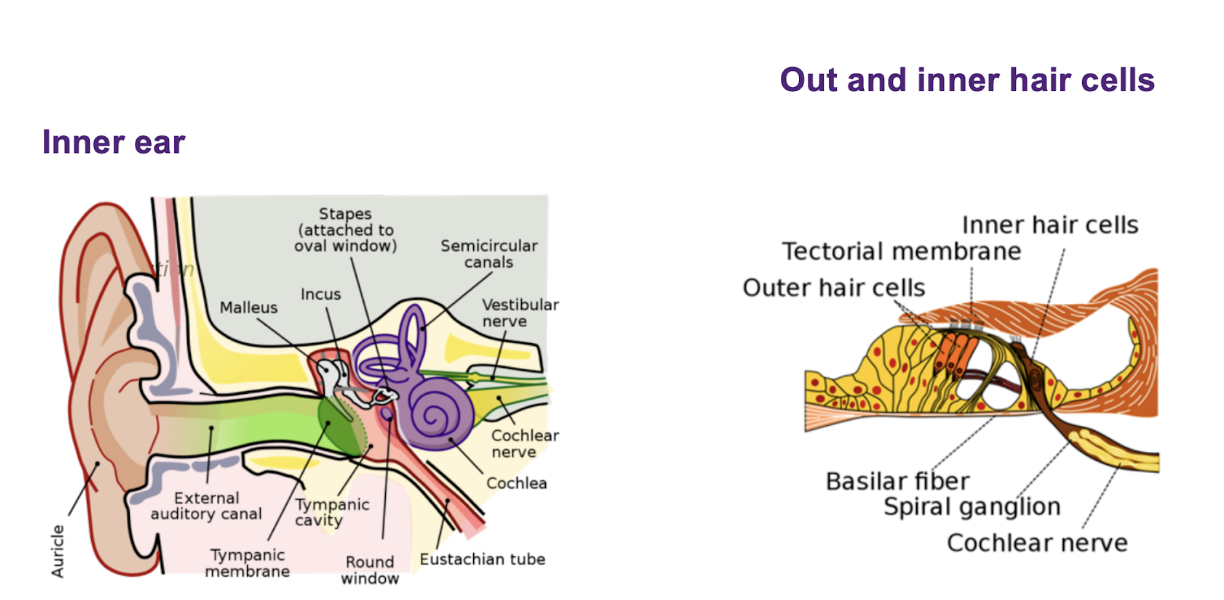
49
New cards
How eyes transfer light into signals that can be sent
Photoreceptors - contain light sensitive chemicals called pigments which absorb photons of light.
Process that changes membrane conductance of photoreceptor causing a wave of depolarization.
Ganglion cells gather signals from back of photoreceptors and these converge to form the optic nerve.
\
Important characteristics of photoreceptors:
* Pigment that absorbs light contained in outer segment positioned on back of retinae, away from light.
* Limits human eye as an optical instrument as light must pass through a no. of cellular layers which retract light and blur image before reaching photoreceptors
Process that changes membrane conductance of photoreceptor causing a wave of depolarization.
Ganglion cells gather signals from back of photoreceptors and these converge to form the optic nerve.
\
Important characteristics of photoreceptors:
* Pigment that absorbs light contained in outer segment positioned on back of retinae, away from light.
* Limits human eye as an optical instrument as light must pass through a no. of cellular layers which retract light and blur image before reaching photoreceptors
50
New cards
Blind spot
Optic nerve must pass through surface of retina to carry signal - No photoreceptors here = blind spot
Perceptual filling - Brain assumes what is on either side of blind spot
Perceptual filling - Brain assumes what is on either side of blind spot
51
New cards
Naïve realism
Mistaken notion veridical images reach retinae
52
New cards
Colour vision
Colour is associated with different wavelengths of light.
Range of colours an animal can see is determined by range of wavelength their photoreceptors can process. (Humans, 400nm (blue) > 700nm (red)
\
Cones - Types of photoreceptors.
Humans rely on 3: trichromats
1\. Short – 430nm (blue)
2\. Medium – 530nm
3\. Long – 570nm (red)
Colour vision is detection of ration of the above 3 colours.
* Grey = All equal, White = All max, Black = All none
\
Colour consistency
Physical objects refract a range of different wavelengths and this is
affected by lighting. E.g the dress
* Our visual systems strive to subtract the impact of lighting away
from our impressions of colour
Range of colours an animal can see is determined by range of wavelength their photoreceptors can process. (Humans, 400nm (blue) > 700nm (red)
\
Cones - Types of photoreceptors.
Humans rely on 3: trichromats
1\. Short – 430nm (blue)
2\. Medium – 530nm
3\. Long – 570nm (red)
Colour vision is detection of ration of the above 3 colours.
* Grey = All equal, White = All max, Black = All none
\
Colour consistency
Physical objects refract a range of different wavelengths and this is
affected by lighting. E.g the dress
* Our visual systems strive to subtract the impact of lighting away
from our impressions of colour
53
New cards
Primary visual cortex
Signals leave eye via optic nerve
Optic chiasm – signals cross so info from other side of visual space travels to 1 side of the brain.
LGN – subcortical brain structures
Primary visual cortex at back of brain first to receive stimulus.
Diagnosing problems:
Problem specific info in 1 eye = eye
1 side of visual space regardless of which eye = damage to brain
Optic chiasm – signals cross so info from other side of visual space travels to 1 side of the brain.
LGN – subcortical brain structures
Primary visual cortex at back of brain first to receive stimulus.
Diagnosing problems:
Problem specific info in 1 eye = eye
1 side of visual space regardless of which eye = damage to brain
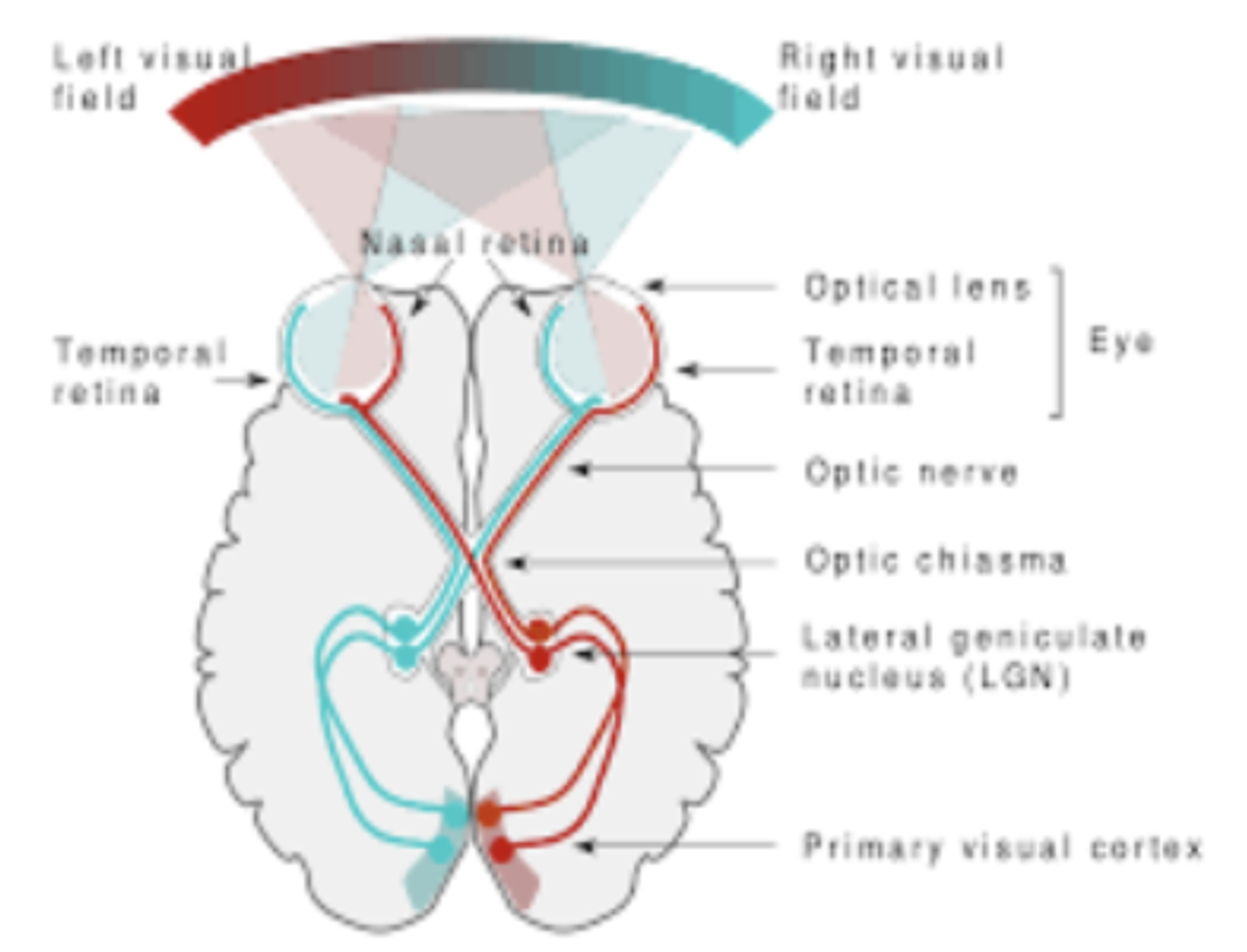
54
New cards
V1
* 2 V1’s, 1 in each hemisphere
* Responds to input from 1 side of visual space
* Responses to input at bottom of visual field mapped toward top of V1 and vice versa.
* Portions of V1 damaged = report being blind to regions of visual field.
V1 responds to inputs we cannot see
* Necessary for normal conscious visual experiences, without it, people report blindness. But we cannot see all V1 activity
* Responds to input from 1 side of visual space
* Responses to input at bottom of visual field mapped toward top of V1 and vice versa.
* Portions of V1 damaged = report being blind to regions of visual field.
V1 responds to inputs we cannot see
* Necessary for normal conscious visual experiences, without it, people report blindness. But we cannot see all V1 activity
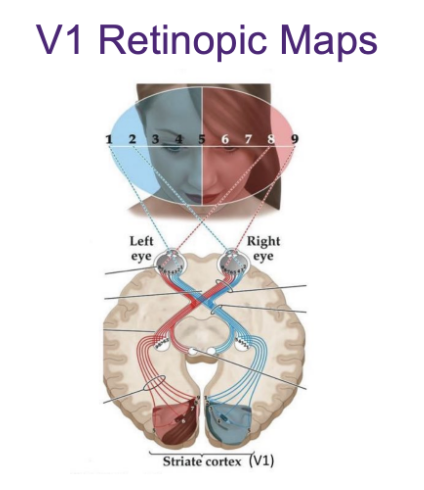
55
New cards
Blindsight
People think they are blind when they are not.
* Damage to primary visual cortex V1
* Damage to primary visual cortex V1
56
New cards
Perimetry
Determining extent of blindness following damage to visual systems.
Patients fixate a point and we flash spots of light at different areas in visual field - yes and no response.
Something interesting happened to patients when asked if the flash occurred left or right or was green or red - patients reporting blindness due to V1 damage performed well above chance.
* Shows some visual operations can occur without primary visualcortex activity
Patients fixate a point and we flash spots of light at different areas in visual field - yes and no response.
Something interesting happened to patients when asked if the flash occurred left or right or was green or red - patients reporting blindness due to V1 damage performed well above chance.
* Shows some visual operations can occur without primary visualcortex activity
57
New cards
Signal detection theory
Describes how to measure sensory sensitivity in conditions of
uncertainty
* To measure sensitivity, you measure hit rate and false alarm
rate.
* =1, participant displayed 0 sensitivity
* If has any sensitivity – hit rate > false alarm rate
uncertainty
* To measure sensitivity, you measure hit rate and false alarm
rate.
* =1, participant displayed 0 sensitivity
* If has any sensitivity – hit rate > false alarm rate

58
New cards
Functional Modularity and the blinding problem
Response selectivity - type of input to which cell will respond
* Visual cells in eye and LGN respond well to simple spots of light
* Cortical cells do not and respond to more complex units - respond to oriented inputs instead of spots of light.
Refers to the fact our brains contain multiple regions that are specialized for processing different visual properties - colour, motion and faces
* Visual cells in eye and LGN respond well to simple spots of light
* Cortical cells do not and respond to more complex units - respond to oriented inputs instead of spots of light.
Refers to the fact our brains contain multiple regions that are specialized for processing different visual properties - colour, motion and faces
59
New cards
Human vision
Processing hierarchy wherein cells at progressive stages of processing respond to increasingly complex features.
V1 – responds to simple things e.g bars of light with colour, moving particular direction. Cells in V1 project to other cortical brain regions for increasing complexity.
V4 – Large no. cells tuned to colour, very few directions based.
V5 – Cells are direction tuned; none respond well to colour
V1 – responds to simple things e.g bars of light with colour, moving particular direction. Cells in V1 project to other cortical brain regions for increasing complexity.
V4 – Large no. cells tuned to colour, very few directions based.
V5 – Cells are direction tuned; none respond well to colour
60
New cards
Facial recognition
Whole network of cortical brain regions responds to faces - Temporal lobe
* Superior temporal sulcus (STS)
* Optical face area (OFA)
* Fusiform face area (FFA)
Prosopagnosia - Face blindness
Cerebral akinetopsia - Means without motion vision
* Superior temporal sulcus (STS)
* Optical face area (OFA)
* Fusiform face area (FFA)
Prosopagnosia - Face blindness
Cerebral akinetopsia - Means without motion vision
61
New cards
Hemisphere
Lateralised functions – some brain functions rely more on one side than the other.
* Crossed (contralateral - opposite) functions - movement, sensation, vision
* Left - Right body movement, sensation and vision (Not left eye/right eye - Left visions from both eyes go to right hemisphere)
* Right - Left body
NO DOMINANT HEMISPHERE
* Crossed (contralateral - opposite) functions - movement, sensation, vision
* Left - Right body movement, sensation and vision (Not left eye/right eye - Left visions from both eyes go to right hemisphere)
* Right - Left body
NO DOMINANT HEMISPHERE
62
New cards
Left Hemisphere
Language (Usually), comprehension, speech, reading
63
New cards
Right Hemisphere
Tone of voice/prosody
Face perception
Perceptual grouping
Face perception
Perceptual grouping
64
New cards
Corpus callosum
Connects hemispheres through axons of nerve fibres and allows
transfer of info
transfer of info
65
New cards
Inter-hemispheric communication
Stimuli presented in left field of vision will be processed in right but
must cross to left hemisphere to report what was seen
must cross to left hemisphere to report what was seen
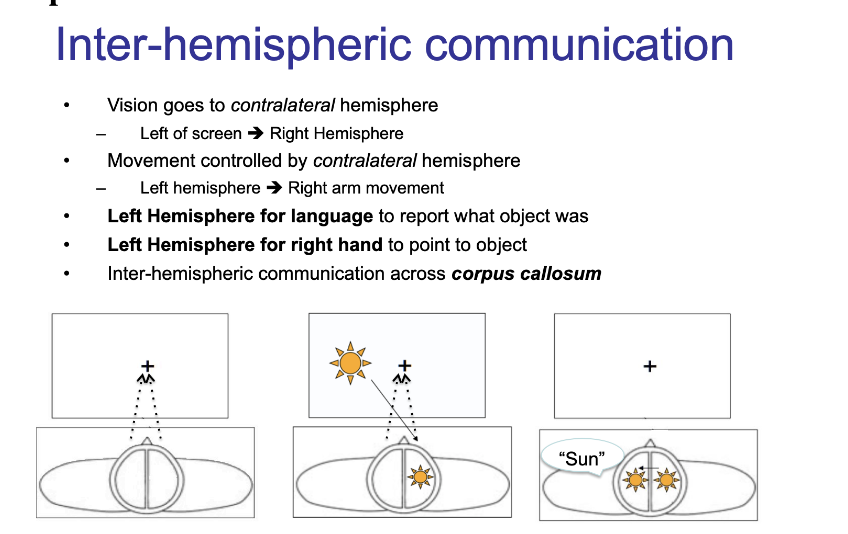
66
New cards
Brain laterality “Split-brain”
“Split Brain” – severed corpus callosum - Last resort treatment for epilepsy as stops seizure spreading to another hemisphere.
These patients were used in many experiments and found that the hemispheres were able to work independently of each other.
These patients were used in many experiments and found that the hemispheres were able to work independently of each other.
67
New cards
Hippocampus (memory)
Limbic system - Medial temporal lobe
Memory forming new episodic memories
Spatial navigation - mental map of familiar environment
* Memory is not 1 thing, but different components mediated by different parts of brain.
Memory forming new episodic memories
Spatial navigation - mental map of familiar environment
* Memory is not 1 thing, but different components mediated by different parts of brain.
68
New cards
Short-term Memory
Lasts several seconds
Can mentally rehearse to remember things - H.M who had has
hippocampus removed
Can mentally rehearse to remember things - H.M who had has
hippocampus removed
69
New cards
Long-term Memory
1\. Declarative – conscious recall (Things you can declare) - Hippocampus
* Episodic – memory of past events
* Semantic – Facts and basic knowledge
2\. Procedural – Not for conscious recall
* Skills you have learnt (H.M could learn new skills but could not recall learning them)
Long-term memory requires encoding (laying down new memories) and retrieval (retrieving memories for conscious recall)
* Episodic – memory of past events
* Semantic – Facts and basic knowledge
2\. Procedural – Not for conscious recall
* Skills you have learnt (H.M could learn new skills but could not recall learning them)
Long-term memory requires encoding (laying down new memories) and retrieval (retrieving memories for conscious recall)
70
New cards
Epilepsy
Hippocampus is common onsite for seizures - Seizures damage hippocampus (decreases neurons) and increase amnesia.
* Epilepsy piggy backs off memory mechanisms - Consolidation of certain synapses and connections in the brain.
* Brain abnormally discharges = consolidated = increase frequency of abnormality = epilepsy
* Epilepsy piggy backs off memory mechanisms - Consolidation of certain synapses and connections in the brain.
* Brain abnormally discharges = consolidated = increase frequency of abnormality = epilepsy
71
New cards
Top-down processes (Perception and Behaviour)
Cognitive control or volitional choice, modulation by prior knowledge and experience
CHOICE, CONSCIOUS - Selective prioritising
CHOICE, CONSCIOUS - Selective prioritising
72
New cards
Bottom-up processes (Perception and Behaviour)
Driven by external stimuli or unconscious states
BIOLOGICAL URGES - Attention captured, things that stand out -
advertisers abuse this
BIOLOGICAL URGES - Attention captured, things that stand out -
advertisers abuse this
73
New cards
Attention (Parietal lobe)
Directing attention (eye movements) to explore visual world
Spatial neglect = parietal lobe damage
Spatial neglect = parietal lobe damage
74
New cards
Selectivity (Parietal lobe)
Select and prioritise stimuli based on location or features (whatever is relevant).
* Moving “spotlight” looking for relevant features - colour, shape
Capacity limited - Resources for attention are limited – we can’t attend to all incoming sensory info; we use attention to filter and prioritise sensory info
* Moving “spotlight” looking for relevant features - colour, shape
Capacity limited - Resources for attention are limited – we can’t attend to all incoming sensory info; we use attention to filter and prioritise sensory info
75
New cards
Spatial awareness (Parietal lobe)
Linking vision to action
* Represents spatial location of objects around us for guiding actions
Map reading and maths ability
* Represents spatial location of objects around us for guiding actions
Map reading and maths ability
76
New cards
Spatial neglect (Parietal lobe)
Damage to parietal lobe in 1 hemisphere. Completely unaware of one
side of space. (Lesions commonly caused by stroke)
* Normal vision
Stimultagnosia – can’t perceive multiple objects simultaneously
side of space. (Lesions commonly caused by stroke)
* Normal vision
Stimultagnosia – can’t perceive multiple objects simultaneously
77
New cards
Frontal lobe
Executive functions:
* Reasoning, planning, problem-solving
* Inhibitory control - Behaviour regulation, selection of appropriate behaviours (ADHD, OCD and reward addictions associated with problems here)
* Working memory
* Reasoning, planning, problem-solving
* Inhibitory control - Behaviour regulation, selection of appropriate behaviours (ADHD, OCD and reward addictions associated with problems here)
* Working memory
78
New cards
Frontal temporal dementia (FTS)
Degeneration/loss of neurons in frontal and temporal lobes
* 2nd most common after Alzheimer’s
Effects:
* Disinhibition - Increasingly inappropriate behaviour
* Apathy - Lacking motivation, withdrawal, emotionally distant
* Loss of empathy
* Deficits in executive functions
* Speech, language and motor deficits
\
Behavioural variant- Main difficulty in social department
\
Language variants
* Non-fluent primary progressive aphasia - Speech is effortful (Damage to brocas area - frontal lobe at back)
* Non-fluent logopenic progressive aphasia - words come out well when they come out but effortful and long pauses (Damage to left hemisphere coming more frontal/parietal into temporal)
\*Both have good understanding and comprehension
* Semantic - Speech sounds fluent, but content is empty/nonsense (temporal lobes affected)
* 2nd most common after Alzheimer’s
Effects:
* Disinhibition - Increasingly inappropriate behaviour
* Apathy - Lacking motivation, withdrawal, emotionally distant
* Loss of empathy
* Deficits in executive functions
* Speech, language and motor deficits
\
Behavioural variant- Main difficulty in social department
\
Language variants
* Non-fluent primary progressive aphasia - Speech is effortful (Damage to brocas area - frontal lobe at back)
* Non-fluent logopenic progressive aphasia - words come out well when they come out but effortful and long pauses (Damage to left hemisphere coming more frontal/parietal into temporal)
\*Both have good understanding and comprehension
* Semantic - Speech sounds fluent, but content is empty/nonsense (temporal lobes affected)
79
New cards
Habituation
Initially strong response is weakened by repeated exposure
Shows how relatively unimportant stimulus comes to be ignored (to not waste energy)
Shows how relatively unimportant stimulus comes to be ignored (to not waste energy)
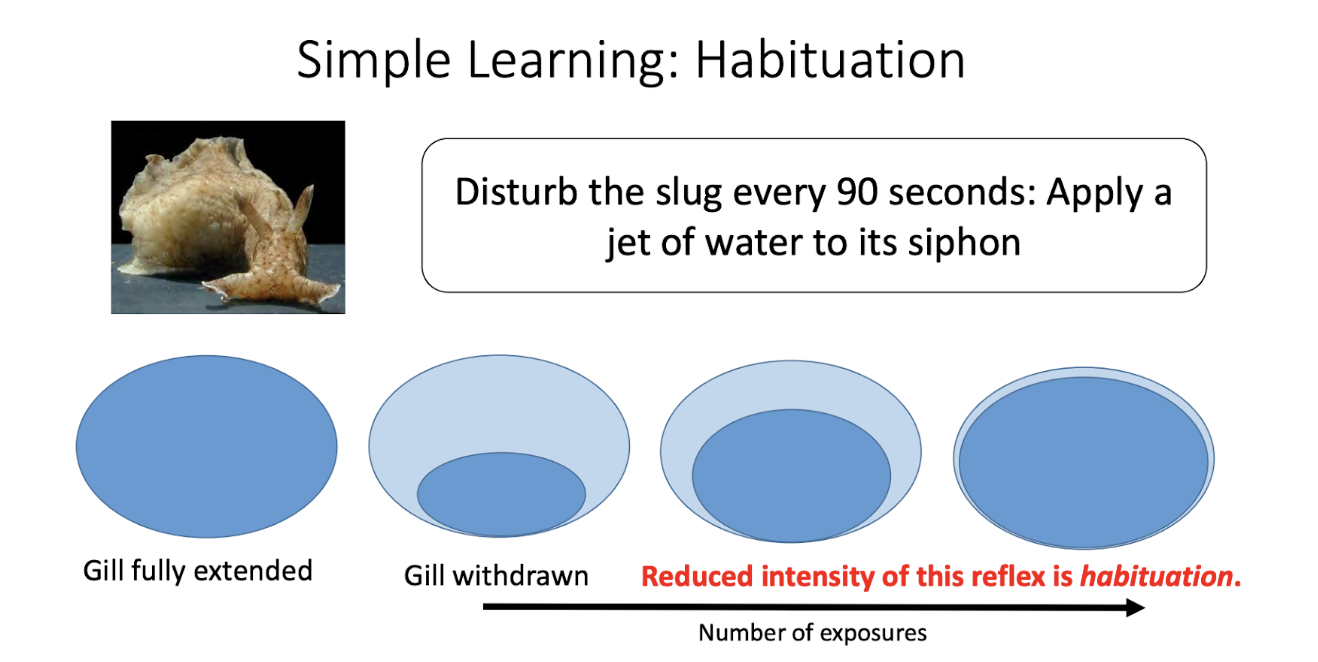
80
New cards
Sensitization
Initially weaker response is strengthened by repeated exposure
Shows how organism becomes more vigilant about stimulus.
“Better safe than sorry principle”
Shows how organism becomes more vigilant about stimulus.
“Better safe than sorry principle”
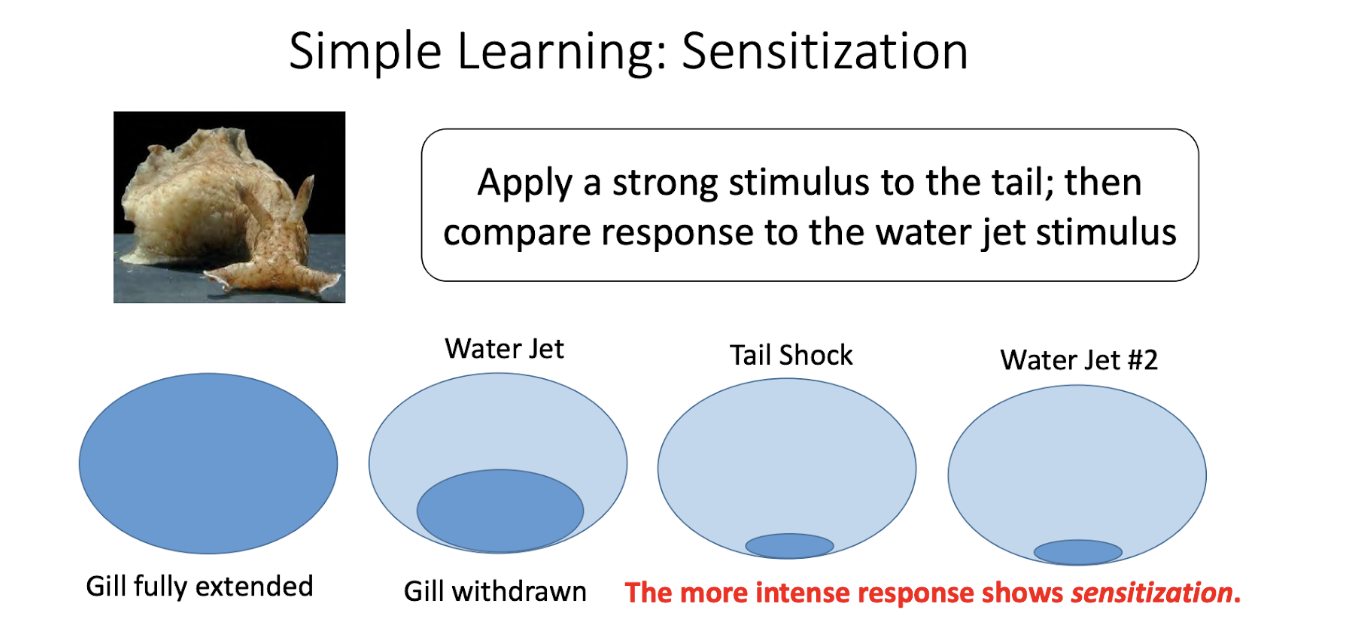
81
New cards
Classical conditioning
Associations learned through experience
Previously neutral stimulus elicits same response after being paired with another stimulus.
Conditioned response elicited through associations between conditioned stimulus and unconditioned stimulus
Previously neutral stimulus elicits same response after being paired with another stimulus.
Conditioned response elicited through associations between conditioned stimulus and unconditioned stimulus
82
New cards
Operant conditioning
Learning based on whether an action is followed by satisfying or unsatisfying consequences. Learning depends on:
1\. Behaviours of organism
2\. Consequences of behaviours
1\. Behaviours of organism
2\. Consequences of behaviours
83
New cards
Therdike’s Law of effect
Behaviours that are followed by a satisfying outcome are more likely to be repeated.
Reinforcement – outcome that increases strength, frequency
Punishment – Out come that decreases
Reinforcement – outcome that increases strength, frequency
Punishment – Out come that decreases

84
New cards
Schedule of reinforcement
Type of consistency matters
1\. Continuous reinforcement - Every instance
2\. Partial reinforcement - Some instances
1\. Continuous reinforcement - Every instance
2\. Partial reinforcement - Some instances
85
New cards
Varieties of partial reinforcement
Schedules
* Interval – Time based reinforcement
* Ratio – response-based reinforcement - Unlike interval, frequency of behaviour is considered (not just did it or did it not happen within this time interval
Type
* Fixed – Reinforcement provided regularly
* Variable – Reinforcement is irregular
* Interval – Time based reinforcement
* Ratio – response-based reinforcement - Unlike interval, frequency of behaviour is considered (not just did it or did it not happen within this time interval
Type
* Fixed – Reinforcement provided regularly
* Variable – Reinforcement is irregular
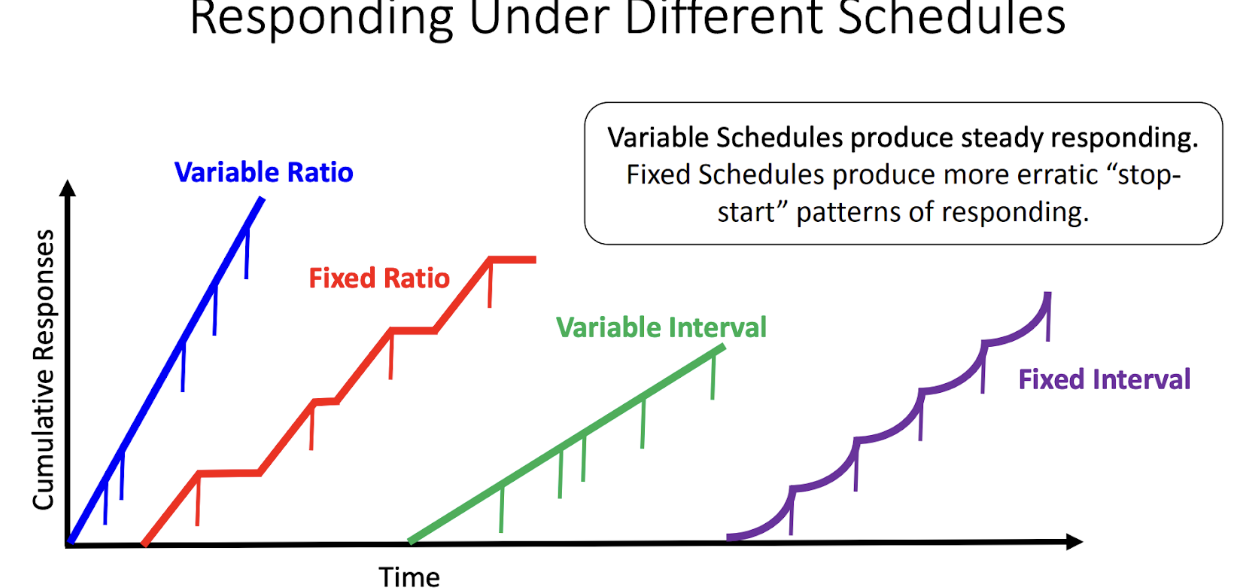
86
New cards
Multistore model of memory
Memory is usually referred to as a single entity - Really an umbrella term.
* 3 types: Sensory, short-term and long-term
The retention of information over time
Encoding > Storage > Retrieval
* 3 types: Sensory, short-term and long-term
The retention of information over time
Encoding > Storage > Retrieval
87
New cards
Sensory memory
Sensory memory store for each sense modality
* Must be attached and transferred to short-term memory to
avoid being forgotten.
Responsible for storing “raw” modality-specific sensory information
* Eye > iconic memory > capacity:12+ items >
* Must be attached and transferred to short-term memory to
avoid being forgotten.
Responsible for storing “raw” modality-specific sensory information
* Eye > iconic memory > capacity:12+ items >
88
New cards
Short-term memory
* Not modality specific
Contents aligned with current state of awareness
A bottleneck for which information must pass through if it wants to be repeated or reported.
* Capacity: 7+- 2 items
* Persists for 20-30 seconds
* Time-based decay
Rehearsal improves likelihood of transfer to long-term memory otherwise forgotten
Contents aligned with current state of awareness
A bottleneck for which information must pass through if it wants to be repeated or reported.
* Capacity: 7+- 2 items
* Persists for 20-30 seconds
* Time-based decay
Rehearsal improves likelihood of transfer to long-term memory otherwise forgotten
89
New cards
Long-term memory
* Capacity: Massive (maybe unlimited)
Once encoded in long-term memory, retention is permanent
* Memory becomes increasingly robust to forgetting as information passes through successive stores.
In order to demonstrate memory for any event, one must engage in selective attention, awareness and recognition
Once encoded in long-term memory, retention is permanent
* Memory becomes increasingly robust to forgetting as information passes through successive stores.
In order to demonstrate memory for any event, one must engage in selective attention, awareness and recognition
90
New cards
Interference (memory)
Adding distractor items = makes it harder to pinpoint appropriate information and takes up space in short term memory.
91
New cards
Free recall and serial position
Ability to recall information is dependent on the order it is given
92
New cards
Recency effect
End of list items. In STM
93
New cards
Primary effect
Start of list items. Items maintained in STM by rehearsal which facilitates transfer to LTM to free up STM space. The middle items are unlikely to have experienced enough rehearsal to be transferred into long-term memory and are therefore, forgotten when new words are added
94
New cards
Cues and retrieval
Improved likelihood of success by adding cues to “trigger” retrieval of target information.
While associations between cues and memory can be helpful, changes to context can result in retrieval of inappropriate information > Interference
While associations between cues and memory can be helpful, changes to context can result in retrieval of inappropriate information > Interference
95
New cards
Encoding specificity principle
Retrieval is facilitated when cues that are presented at encoding are
also present at retrieval
* Incidental features of our environment (and our mental state) can become associated with target information
also present at retrieval
* Incidental features of our environment (and our mental state) can become associated with target information
96
New cards
Depth of processing
Deeper encoding and processing = superior memory performance
97
New cards
Forms of interference
1\. Proactive interference – older information disrupts retrieval of more recent information
2\. Retroactive interference – more recent information disrupts retrieval of older information
Not possible to predict in advance which form interference will take Is dependent on task, context and other situational factors unique to individuals.
2\. Retroactive interference – more recent information disrupts retrieval of older information
Not possible to predict in advance which form interference will take Is dependent on task, context and other situational factors unique to individuals.